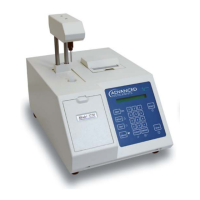18
Power Supply (Serial Suffix D and Higher) Advanced
™
Osmometer 3250/Cryoscope 4250 Service Manual
Power Supply (Serial Suffix D and Higher)
The power entry assembly interfaces the AC voltage presented to the instrument with the
AC/DC switching power supply. The power supply provides the power to run the main
printed circuit board set (±12 VDC, +5 VDC), the thermoelectrics (5 VDC), the fan (12 VDC),
the stir/freeze coil (12 VDC), the internal printer (12 VDC), and the motor and control circuits
(+24 V).
Front End
The sample thermistor measures the temperature of the sample. The thermoelectrics (whose
duty cycle is controlled through the block probe/thermistor) supercool the sample. The stir/
freeze wire constantly stirs the sample to guarantee uniform cooling. When the supercooled
sample reaches a set temperature (3000 mOsm for the low range and 4800 mOsm for the
high range, by default, in the 3250, and 3000 m °C in the 4250), the stir/freeze wire "buzzes"
causing the sample to freeze. During a test, the fan duty cycle tracks the thermoelectrics
duty cycle -10%. If duty cycle drops below 20%, the fan is off. In between tests, the fan runs
as required to maintain the software controlled target temperatures.
325605 Control Board Set Description
General: The control board set is made up of two printed circuit boards in a motherboard/
daughterboard configuration.
325620/425620/325621/425621 Processor Board
Processor: The processor used is an Intel 80C186 16-bit embedded processor. The 80C186
contains three programmable 16-bit timers, two serial ports, programmable interrupts, 1
mega-byte of memory address space, and 64 kilobytes of input/output (I/O) address space.
The processor uses an external 32 MHz crystal to generate the internal 16 MHz system clock.
The processor controls access to all memory and all I/O.
Memory Map: The 1 mega-byte of memory address space contains read-only memory (Flash
EPROM), read/write memory (static RAM), and the real time clock. About half of the address
space is unused, allowing for future expansion. The read-only memory is divided into four
sections: reset vector, boot code, parameter blocks (unused), and application code. The reset
vector tells the processor where to first start executing code; in this case, the boot code is
executed first after reset. The boot code determines if new software will be downloaded by
checking if the dip switch is in the “PROGRAM” position.
If it is, the boot code waits for new software to be downloaded through the serial port. If not,
the application code starts.
The real time clock maintains the current date and time, and contains nonvolatile memory
where the instrument’s operation parameters are stored. A internal lithium battery preserves
the contents of the nonvolatile memory when the instrument is turned off. Finally, the read-
write memory is used for stacks, variables, etc., except for the small section allocated for the
interrupt vectors. The interrupt vectors tell the processor what code to run when an interrupt
occurs, and functions similarly to the reset vector.
Please note that all memory addresses and sizes are always defined in terms of bytes, even
though the processor handles words (1 word = 2 bytes, 1 byte = 8 bits; therefore, 16 bits = 1
word).

